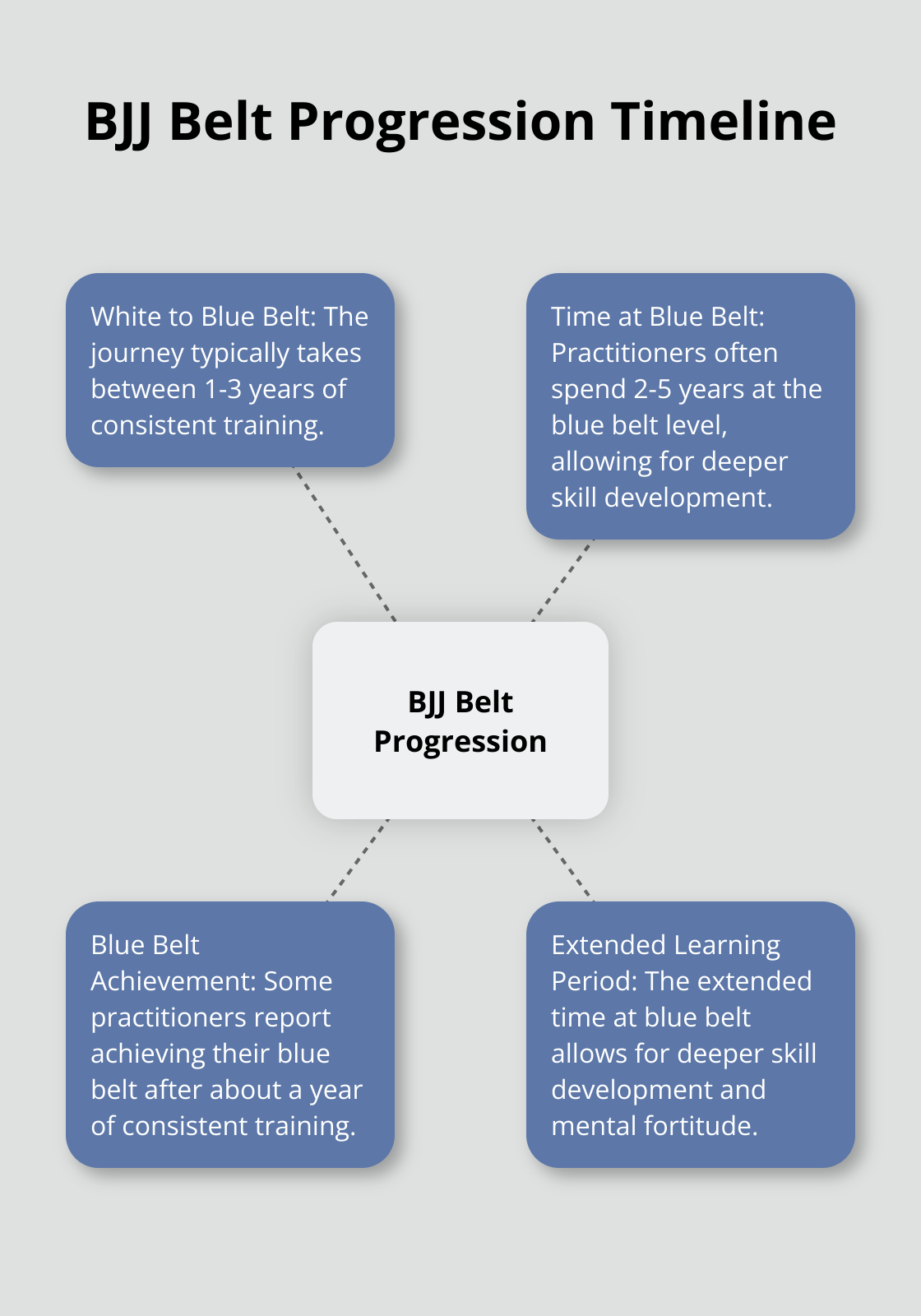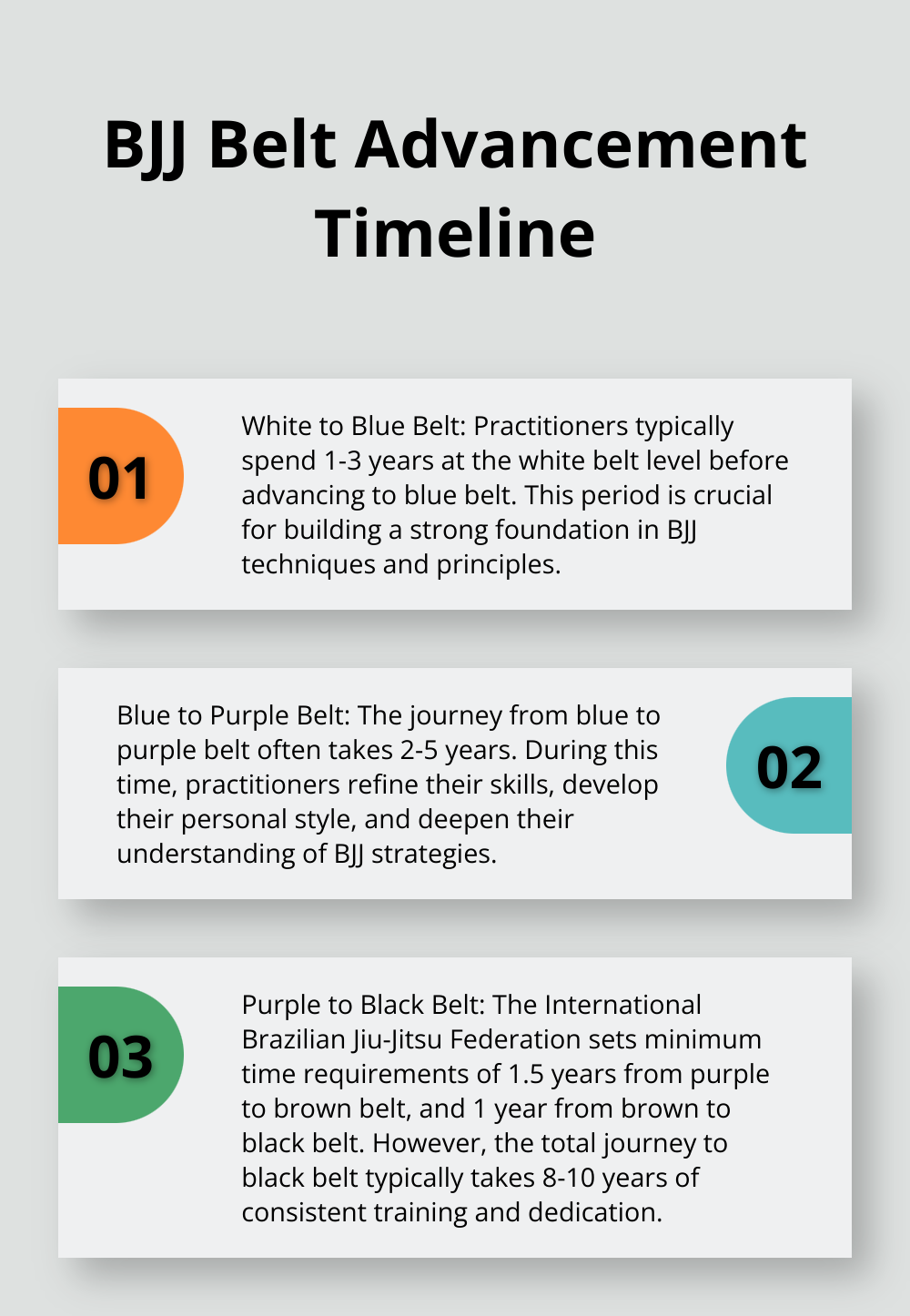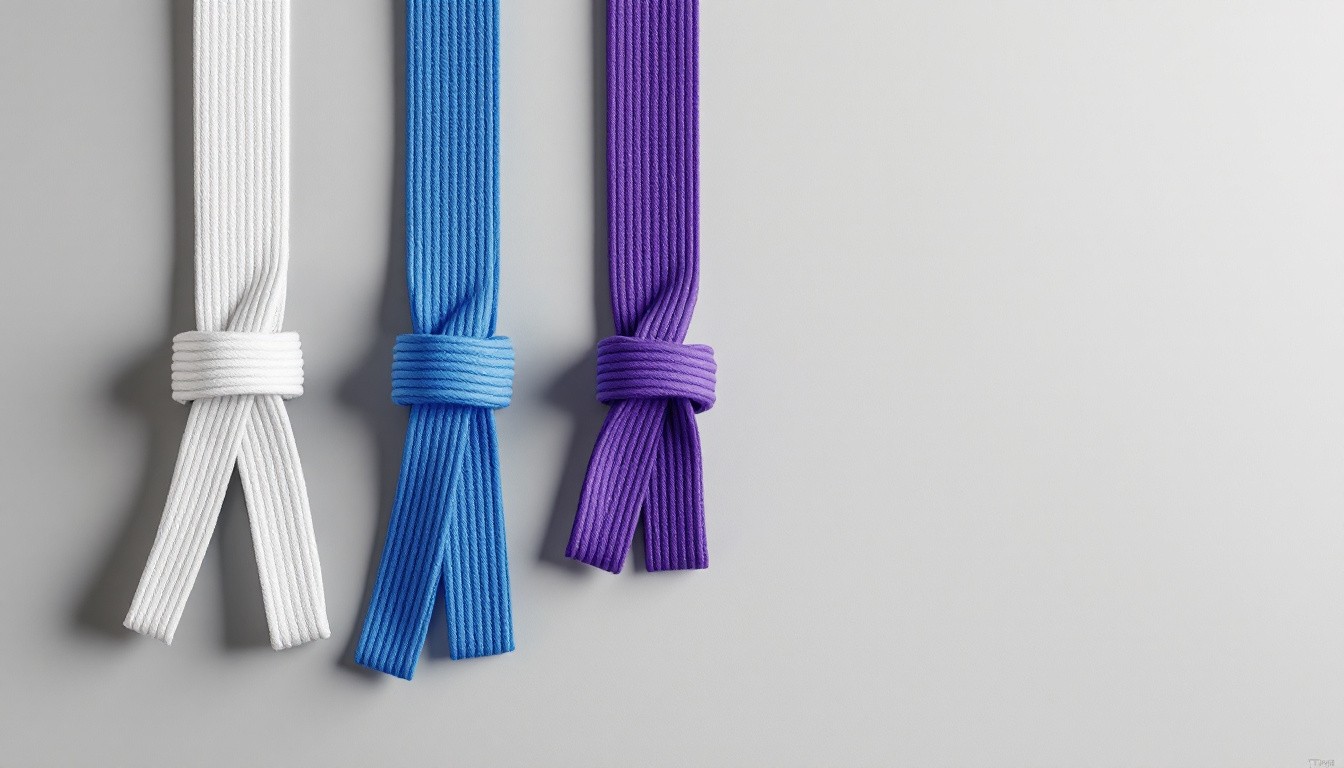At Jiu jitsu, we understand the significance of each belt color in Brazilian Jiu-Jitsu. These ranks represent more than just progress; they embody the dedication, skill, and mindset of practitioners.
In this post, we’ll explore the meaning behind Jiu-Jitsu belt colors, from the foundational white to the prestigious black. We’ll discuss the key skills, challenges, and time investments associated with each rank, providing valuable insights for BJJ enthusiasts at every level.
What Does a White Belt Mean in BJJ?
The Foundation of Brazilian Jiu-Jitsu
The white belt in Brazilian Jiu-Jitsu (BJJ) marks the start of an exciting journey. It forms the foundation upon which all future skills are built. At this stage, practitioners learn the fundamental techniques and positions that constitute the core of BJJ.
Mastering the Basics
White belts typically spend 2-3 years honing their skills before they progress to blue belt. During this time, they focus on learning essential techniques such as:
- Guard positions (closed, open, half)
- Basic submissions (armbar, triangle, kimura)
- Escapes from common positions
- Proper falling and rolling techniques
These fundamentals prove vital for developing a solid BJJ game.

Overcoming Common Challenges
White belts often face several hurdles in their BJJ journey. One of the most significant is managing frustration. It’s common to feel overwhelmed when sparring with more experienced practitioners. However, this discomfort plays a key role in the learning process.
Another challenge involves developing body awareness and coordination. Many new practitioners struggle to execute techniques smoothly. Regular drilling and repetition help overcome this hurdle.
Building Mental Toughness
The white belt phase isn’t just about physical skills. It also involves developing mental resilience. Learning to stay calm under pressure, accepting defeats as learning opportunities, and maintaining consistency in training are all vital aspects of the white belt journey.
Embracing the Journey
Every BJJ black belt was once a white belt. The journey of a thousand miles starts with a single step, and in BJJ, that step is the white belt. Embrace the challenges, stay consistent, and you’ll see rapid progress.
As white belts lay the groundwork for their BJJ journey, the next milestone awaits: the blue belt. This rank represents the first major achievement in a practitioner’s path and brings with it a new set of skills and expectations.
Blue Belt: The First Major Milestone
Significance of Blue Belt Achievement
Achieving a blue belt in Brazilian Jiu-Jitsu (BJJ) represents a significant milestone. This rank marks the transition from novice to intermediate level, demonstrating a solid grasp of fundamental techniques and strategies. Blue belts have proven their commitment to the art and their ability to apply basic concepts effectively.
Advanced Techniques and Strategies
Blue belts build upon the foundation laid during their white belt journey. They refine their understanding of positional control, submissions, and escapes. At this stage, practitioners adopt a more nuanced approach to rolling, focusing on timing, pressure, and leverage (rather than relying solely on strength or athleticism).
Personal Style Development
As blue belts progress, they start to discover their preferred techniques and positions. This exploration period allows practitioners to cultivate a unique BJJ style that aligns with their physical attributes and mental approach to the sport. Some may excel in guard play, while others might prefer top positions or submission hunting.
Time Investment and Dedication
The journey from white to blue belt typically takes between 1-3 years of consistent training. However, the time spent at blue belt level often extends longer, ranging from 2-5 years. This extended period allows for deeper skill development and mental fortitude. Some practitioners report achieving their blue belt after about a year of consistent training, emphasizing the importance of patience and perseverance in BJJ progression.
Physical and Mental Growth
Blue belts experience significant physical and mental improvements. Physically, they develop increased endurance, flexibility, and body awareness. Mentally, blue belts cultivate problem-solving skills, strategic thinking, and emotional resilience. These physical benefits become more pronounced as practitioners advance through the ranks.

As blue belts continue to refine their skills and develop their unique style, they prepare for the next phase of their BJJ journey: the purple belt. This intermediate rank brings new challenges and opportunities for growth, bridging the gap between the foundational blue belt and the advanced brown belt.
Advanced Ranks: Mastering the Art
Purple Belt: The Pivotal Stage
The purple belt signifies a critical transition in a practitioner’s Brazilian Jiu-Jitsu (BJJ) career. At this level, practitioners transition from technique collection to strategic mastery. Purple belts focus on depth, efficiency, and momentum in their training.
Purple belts often start to develop their own unique style of BJJ. They no longer just follow instructions but actively solve problems during rolls. This rank allows practitioners to truly understand the concept of flow in BJJ.
Brown Belt: The Final Preparation
Achieving brown belt status requires 6-7 years of dedicated training. At this level, practitioners must demonstrate a comprehensive understanding of BJJ techniques and strategies.
Brown belts often assume teaching responsibilities, guiding lower-ranked students. This teaching experience proves essential for their own development, as it requires them to articulate and demonstrate techniques clearly.
The focus at brown belt level shifts towards technique refinement and development of a more nuanced understanding of BJJ. Brown belts must execute techniques with precision and understand the subtle details that make moves effective.
Black Belt: The Continuous Journey
Contrary to popular belief, achieving a black belt does not mark the end of the BJJ journey (it’s often considered just the beginning). Black belts typically invest 8-10 years of consistent training to reach this level.
At black belt level, practitioners must master the fundamental techniques of BJJ and possess a deep understanding of its principles. They adapt their game to different opponents and situations with ease.
However, learning never stops. Many black belts continue to train regularly, compete, and seek out new knowledge. They often specialize in certain aspects of BJJ, becoming experts in particular techniques or positions.
Time Investment and Dedication
The time investment required to progress through these advanced ranks is substantial. The International Brazilian Jiu-Jitsu Federation sets minimum time requirements:
- Purple to Brown: 1.5 years
- Brown to Black: 1 year
These are minimum requirements, and in practice, the journey often takes much longer. The dedication extends beyond mat time. Advanced practitioners often supplement their training with strength and conditioning work, study of BJJ theory, and even cross-training in complementary martial arts.

Final Thoughts
The journey through Jiu-Jitsu belt colors represents dedication, perseverance, and personal growth. Each rank signifies a milestone in a practitioner’s development, cultivating a mindset of continuous improvement and resilience. Consistent training hones physical skills, develops mental fortitude, and enhances problem-solving abilities.
Progress in Brazilian Jiu-Jitsu is personal, and each practitioner’s path is unique. The true reward lies in the personal transformation that occurs along the way (not just in achieving the next belt color). Jiu-Jitsu belt colors serve as markers of progress, but the journey itself shapes practitioners into better versions of themselves.
At Souza Grappling Co., we support practitioners at every stage of their BJJ journey. Our facility and expert instructors provide an ideal environment for growth and learning. We offer a supportive community that encourages progress, fosters confidence, and celebrates achievements at every belt rank.




